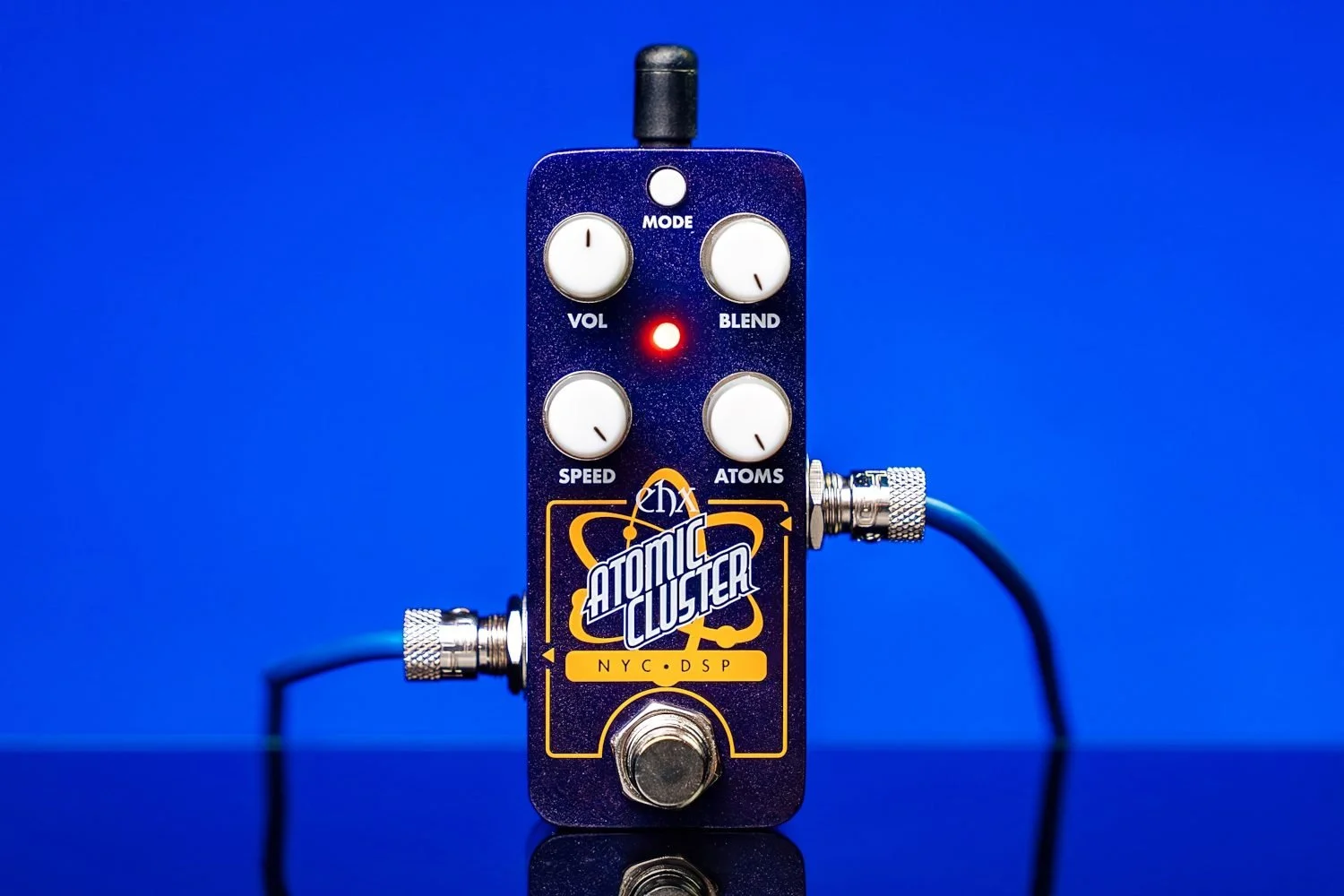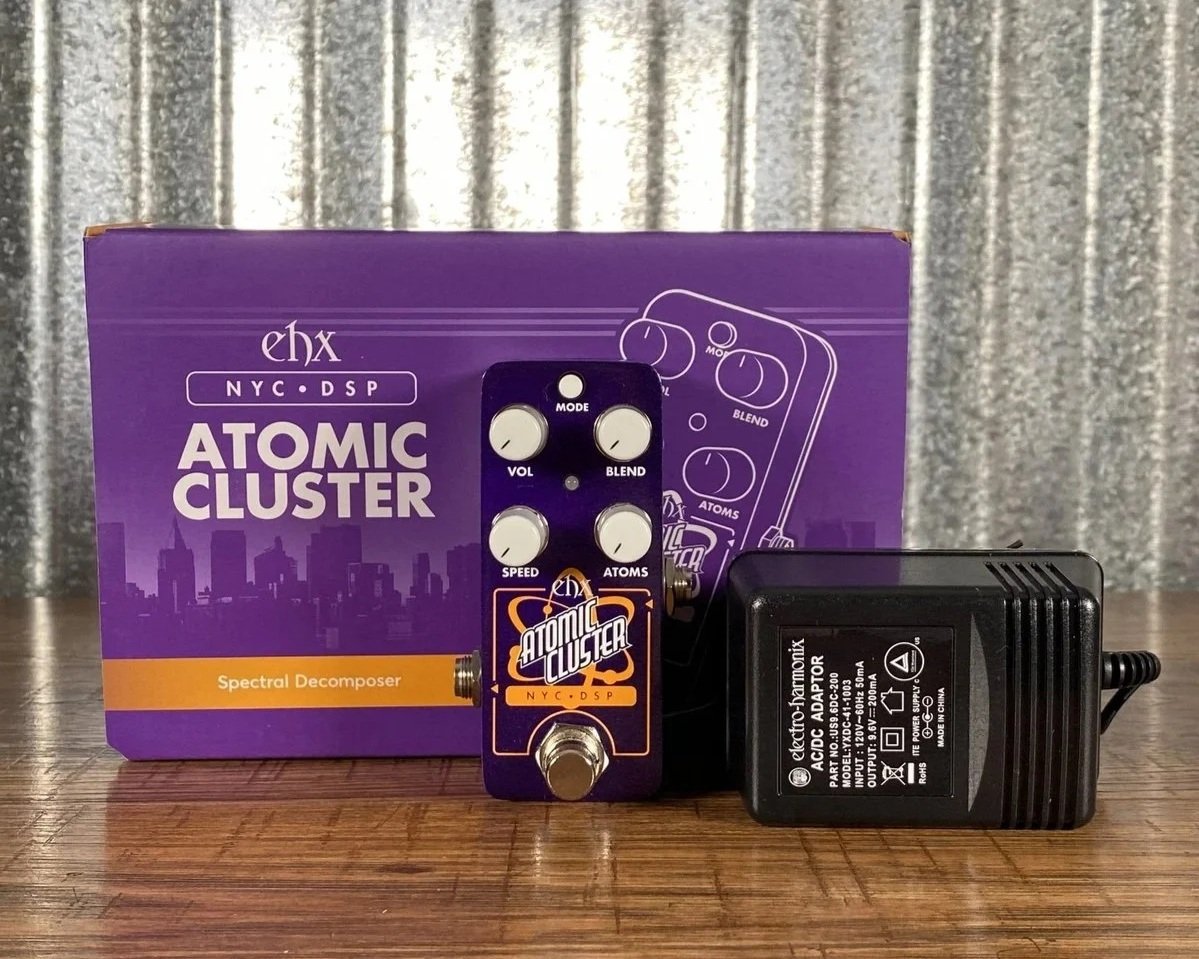EHX Pico Atomic Cluster: A Mini Pedal With Big Spectral Weirdness

Electro-Harmonix has been on a fascinating run lately with their Pico lineup—shrinking ideas down without sanding off the weirdness that makes their pedals memorable. The new Pico Atomic Cluster follows that philosophy but adds its own twist: instead of being a mini remake of a classic, it’s a brand-new effect built around spectral decomposition, fluttering oscillations, and these strangely musical bursts of texture. It’s the kind of design only EHX would attempt in a tiny enclosure. What makes it interesting isn’t just the sound but the concept. The Atomic Cluster treats your signal almost like material to be broken apart and reassembled, producing everything from soft, ambient pads to unpredictable glitchy flickers. It feels retro in spirit—like something out of a 70s experimental lab—but with modern control and a footprint that disappears on your board. It’s compact, curious, and very EHX: a small box with ideas much bigger than its size.
Disclosure: This site contains affiliate links. If you book or purchase through these links, I may earn a commission at no extra cost to you. This helps support the site and keeps my content free. As an Amazon Associate, I earn from qualifying purchases.
What Is the Pico Atomic Cluster?
The Pico Atomic Cluster is a compact spectral-decomposition pedal that breaks your signal into resonant oscillations and fluttering overtones instead of treating it like a traditional modulation source. It belongs to EHX’s Pico series—small, pedalboard-friendly enclosures—but unlike many of its siblings, this isn’t a shrunken-down version of an older design. It’s a new concept built around the idea of “decomposing” your input in real time, then reshaping it into textures that feel part-synth, part-glitch effect, part-ambient processor.
At its core, it generates two distinct behaviors depending on how deep you push it. With subtle settings, it adds harmonic movement and airy, pad-like expansion. Cranked, it becomes chaotic and warbly, producing fluttering sine-wave-like fragments that dance around your original signal. It’s an effect that doesn’t fit neatly into one category, and that’s exactly what makes it intriguing: it’s an experimental sound-design tool disguised as a tiny stompbox.
Tone & Character
The Pico Atomic Cluster’s sound sits in that sweet spot where experimental processing becomes unexpectedly musical. At mild settings, it adds a spectral shimmer that feels more like a drifting pad than an effect pedal. Your notes soften and bloom, almost as if a synth is shadowing your playing. Switching into Smooth mode enhances this side of its personality: chords swell into soft clusters, single notes trail off into airy harmonics, and the whole texture sits just underneath your dry tone without getting in the way.
Dial things the other direction and the pedal reveals its sharper, more chaotic identity. With Atomic set low and Speed pushed higher, the pedal produces rapid, fluttering oscillations that feel like a broken radio shifting between stations—unpredictable but strangely beautiful. Sharp mode exaggerates these moments into something more glitchy and angular, giving you splintered bursts of tone that can punctuate riffs, break up chord progressions, or turn a simple line into a jagged, shifting fragment. It’s not your typical modulation; it’s a spectral reshaping engine that can be subtle, abrasive, or anywhere in between, depending on how far you push it.
Alternatives Worth Considering
If you’re drawn to the Atomic Cluster because it pushes your sound into new shapes, there are a few other pedals that explore that same creative space—each in their own way. They don’t use spectral decomposition, but they open similar doors to texture-building, ambient drift, and controlled chaos. The Chase Bliss Mood MKII is an obvious starting point: part looper, part granular processor, and part ambient machine. It can turn a single chord into a drifting pad or break simple phrases into shimmering fragments. Likewise, the EarthQuaker Devices Afterneath brings its own brand of otherworldly reverb, with tails that smear, bend, and stretch your tone into cavernous, arpeggiated reflections.
If your taste leans a bit more toward glitch or rhythmic mutation, the Red Panda Particle V2 and Boss SL-2 Slicer offer deeper dives into stutters, pitch-warped delays, and motion-based sound design. On the ambient side, pedals like Walrus Audio Slö and Strymon NightSky excel at harmonic swells and washed-out textures that sit somewhere between pad and reverb. And if you want the more eccentric, synthetic edge, the EarthQuaker Devices Rainbow Machine or Meris Enzo can get you into strange harmonic clusters and pitch-driven color in seconds. They’re all different tools, but they share the same promise: they let you step outside the usual modulation box and reshape your sound in ways that feel playful, exploratory, and inspiring.
Verdict
The Pico Atomic Cluster is one of those rare compact pedals that manages to feel genuinely new without demanding a learning curve. It delivers spectral weirdness, ambient softness, and glitch-adjacent chaos in a way that feels immediate and playable, even if you’ve never touched anything in this category before. The control layout keeps things approachable, but the sounds are deep enough that you can easily lose an hour just exploring how your tone breaks apart and re-forms. It’s experimental, but it isn’t fussy or precious about it.
If you’re someone who likes adding texture, movement, or outright strangeness to a guitar or synth rig, this is an easy pedal to recommend. It’s especially appealing if you want something that stands out from the typical modulation choices without needing to dedicate half a pedalboard to it. At its price and size, the Atomic Cluster fills a niche few pedals touch—an affordable doorway into spectral processing that feels both inspiring and fun.
Disclosure: This site contains affiliate links. If you book or purchase through these links, I may earn a commission at no extra cost to you. This helps support the site and keeps my content free. As an Amazon Associate, I earn from qualifying purchases.



